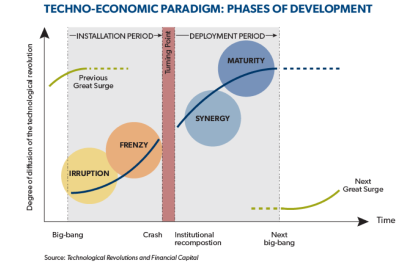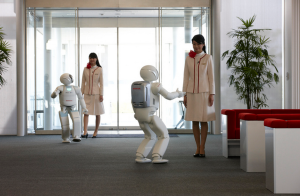 In a few decades, twenty or thirty years — or sooner – robots and their associated technology will be as ubiquitous as mobile phones are today, at least that is the prediction of Bill Gates; and we would be hard-pressed to find a roboticist, automation expert or economist who could present a strong case against this. The Robotics Revolution promises a host of benefits that are compelling (especially in health care) and imaginative, but it may also come at a significant price.
In a few decades, twenty or thirty years — or sooner – robots and their associated technology will be as ubiquitous as mobile phones are today, at least that is the prediction of Bill Gates; and we would be hard-pressed to find a roboticist, automation expert or economist who could present a strong case against this. The Robotics Revolution promises a host of benefits that are compelling (especially in health care) and imaginative, but it may also come at a significant price.The Pareto Principle of Prediction
We find ourselves faced with an intractable paradox: On the one hand technology advances increase productivity and wellbeing, and on the other hand it often reinforces inequalities.
A new study due to be published in the forthcoming Oxford Handbook of Skills and Training by Stuart Elliot visiting analyst at the Organisation for Economic Co-operation and Development (OECD), who incidentally is on leave from the Board on Testing and Assessment of the National Research Council, indicates that technology could replace ‘workers for 80 percent of current jobs.’
In his study Elliot relies on advances in speech, reasoning capabilities and movement capabilities to illustrate how robots and technology can replace jobs. I am in agreement with the general thoughts of the study, although I believe speech recognition is now far more advanced than Elliot states. This element alone will lead to a reduction in many jobs, such as translation over the next five years.
Elliot is not the first to claim that robotics and technology will have such a profound impact on employment or inequality. Michael Hammer, a former MIT professor and prime mover in the restructuring of the workplace in the 1990’s estimated that up to 80 percent of those engaged in middle management tasks were susceptible to elimination due to automation.
In the book Average is Over Professor Tyler Cowen also predicts a hollowed-out labor market, devoid of middle-skill, middle-wage jobs, where 80% or more of our citizens will be unable to prosper. They will become a permanent underclass, unable to improve their lot.
This ‘underclass’ may be happening sooner than Cowen predicted. While there are ‘short term’ adjustments in the employment numbers, the majority are in the low-paying sectors, 73% of ‘new’ jobs are in the bottom of the wage pyramid and temporary employment positions rather than permanent.
The US Bureau of Labor Statistics estimates that among the most rapidly growing occupational categories over the next ten years will be “healthcare support occupations” (nursing aides, orderlies, and attendants) and “food preparation and serving workers” – overwhelmingly low-wage jobs.
As recent as last month the FT reported that: “New technologies are transforming the structure of the US economy but creating only modest numbers of jobs, according to the biggest official survey of businesses, conducted only once every five years.”
In the book Race Against The Machine the authors state: “Digital technologies change rapidly, but organizations and skills aren’t keeping pace. As a result, millions of people are being left behind. Their incomes and jobs are being destroyed, leaving them worse off.”
Speaking at the World Economic Forum in Davos earlier this year, Google’s Eric Schmidt warned that the problem of new technologies substantially changing and replacing jobs will be “the defining one” for the next two or three decades.
Thinking machines
Increasingly, machines are providing not only the brawn but the brains, too, and that raises the question of where humans fit into this picture. Earlier this year, Jörg Asmussen State Secretary in the German Ministry of Labor and Social Affairs emphasized this trend when he said:
“Digitization, or the “second machine age” (as in the title of the best seller by Erik Brynjolfsson and Andrew McAffee), has only just begun. It is in the process of relieving and ultimately replacing first our physical and then our intellectual labor. This trend will be a threat to brainworkers such as accountants and stock-market traders. And check-out clerks at supermarkets will also soon be a thing of the past.”Echoing this, Randall Parker, Professor of Economics at East Carolina University, recently wrote:
“Robots and other automated equipment have increased factory automation so much that factories are a dwindling source of all jobs. The next big target for automation has been and continues to be office work.”In the US manufacturing sector there was a solid increase in sales of 8 percent between 2007 and 2012 but with significant falling employment, the industry shed 2.1m jobs and its payroll dropped $20 billion.
Approximately one out of 25 workers in Japan is a robot, this is in part due to a growing elderly population and declining birthrates, which mean a shrinking workforce, but it is also a fact that global business seeks to drive productivity, efficiency, and effectiveness to new heights with robotics.
This time is different, or maybe not
In his seminal book, The Enlightened Economy, Joel Mokyr argued that: “in Britain the high quality of workmanship available to support innovation, local and imported, helped create the Industrial Revolution.” Dig a little further and Mokyr refers to: “the top 3 to 5 percent of the labor force in terms of skills: engineers, mechanics, millwrights, chemists, clock and instrument makers, skilled carpenters and metal workers, wheelwrights, and similar workmen.”
It was a small minority of the working population that had the skills to help advance the Industrial Revolution, others had to learn new skills to adapt to the technology changes. This time is no different. Just as each revolution sets a higher potential level of productivity each revolution requires a new set of skills to overcome the resistance of the old paradigm, which is deeply embedded in the minds and the practices.
Despite the job losses in the US manufacturing sector factories are increasingly employing more skilled engineers to tend complex equipment and at higher wages, Annual payroll per employee in the manufacturing sector rose from $45,818 in 2007 to $52,686 in 2012.
It’s time to act
Robotic hardware, Artificial Intelligence, automated software and connected networks are only going to get more powerful and capable in the future, and have even bigger impact on jobs, skills and the economy.
The message for all of us can be summed up in a quote from Abraham Lincoln’s second address to Congress.
“As our case is new, so we must think anew, and act anew.”
In his paper Elliot raises a very good question: “Even if alternative jobs are available, how will the displaced workers acquire the necessary skills for the new tasks?” This should be a wake up call. All of us must give serious consideration to our future and learn the skills that will give us the best chance of working WITH the machines. I’ll repeat Lincoln’s statement, since that’s the big takeaway. “As our case is new, so we must think anew, and ACT anew.” These are exciting and challenging times…
The above comes from a Blog that is worth examining. Something about it is presented below
About
 Robots are becoming an integrated part of daily life. My name is Colin Lewis, a Behavioral Economist and Data Scientist who provides research and advisory services in automation, robotics and artificial intelligence.
Robots are becoming an integrated part of daily life. My name is Colin Lewis, a Behavioral Economist and Data Scientist who provides research and advisory services in automation, robotics and artificial intelligence. I believe the Robotic Revolution will come within the next few decades and be more transformative than the Industrial Revolution. This blog reviews the changing area of robotics and its impact on our personal and professional life — Technology is meaningless without people.
Whilst there are concerns about technology and automation displacing many from the workplace I have an optimism for the future and believe the attempt to better the world for all humanity is hidden somewhere within the automated robotic economy.
It would be easy to underestimate the degree to which the robot economy is going to make a difference. Fast-paced and disruptive innovation is becoming increasingly institutionalized and ubiquitous — fundamentally changing the way we work, play and communicate. By tracking trends impacted by automation in social, technological, economic, environmental and political arenas I hope to be able to provide a greater understanding of how to take advantage of new technologies to improve our lives. I will do this by researching the impact of behavior, economics and culture on the future whilst exploring the interactions between technology and society… in that respect, this blog is not about describing the world, it’s about exploring ideas.
Robotenomics.com content has featured in the Financial Times, Harvard Business Review, Bloomberg, O’Reilly Media, Inc Magazine, Business Insider and others. If you wish to know more about my work helping corporations, financial institutions, universities and government to take advantage of data science and the robot economy, send me an email — colin (@) robotenomics.com
Charles Darwin wrote, “It is not the strongest of the species that survives, nor the most intelligent, but the one most responsive to change.”
Personal motto: Apophenia – making connections where none previously existed (overcoming the human tendency of seeing patterns where none actually exist).
No comments:
Post a Comment